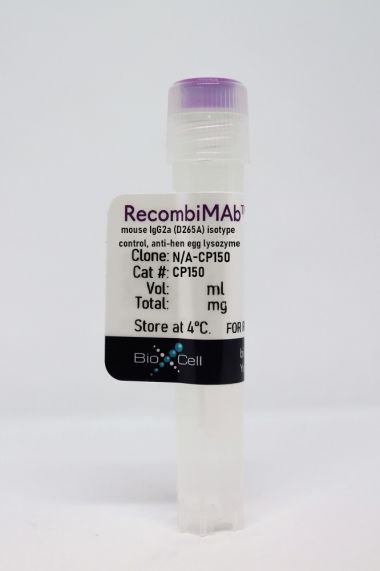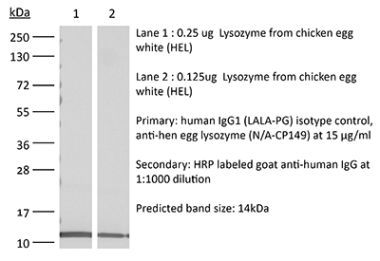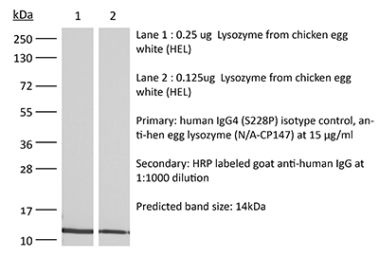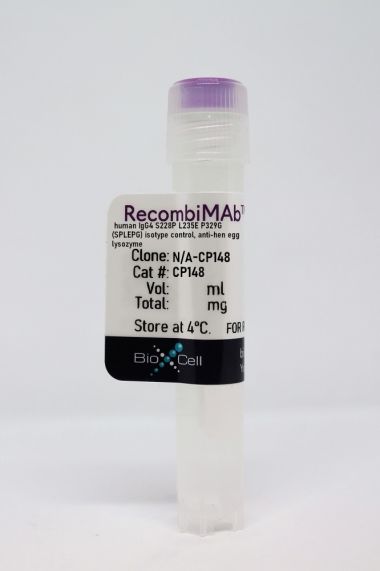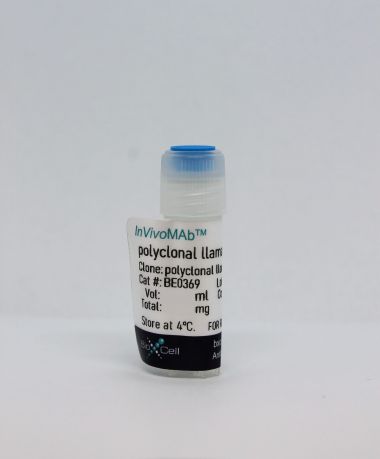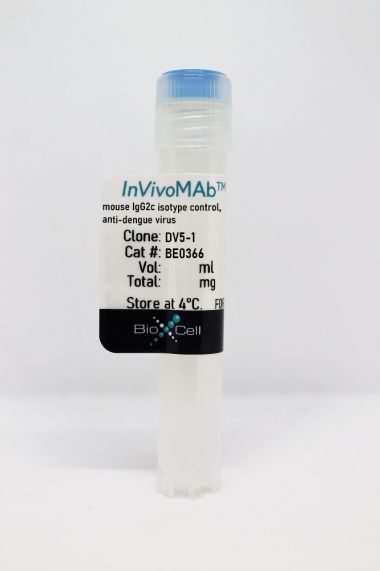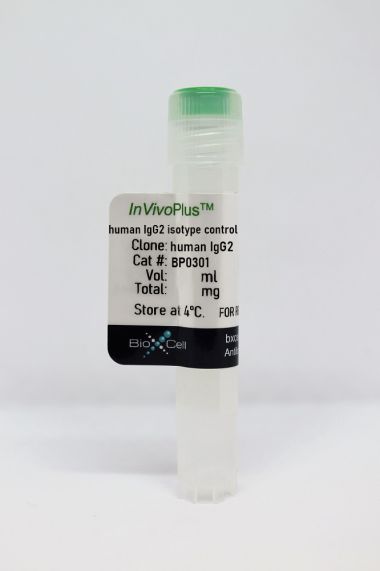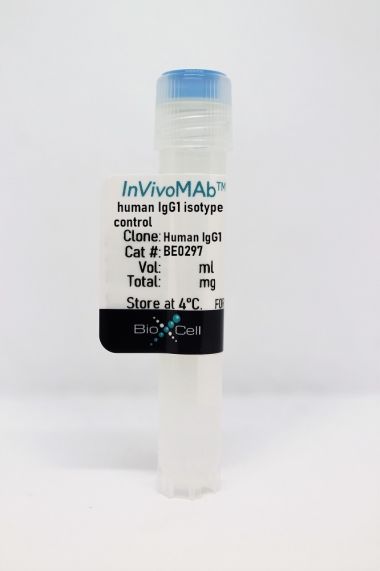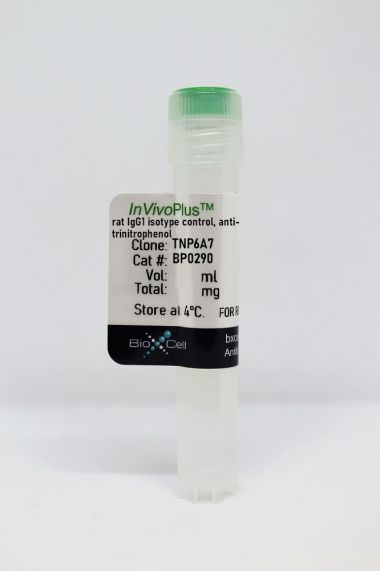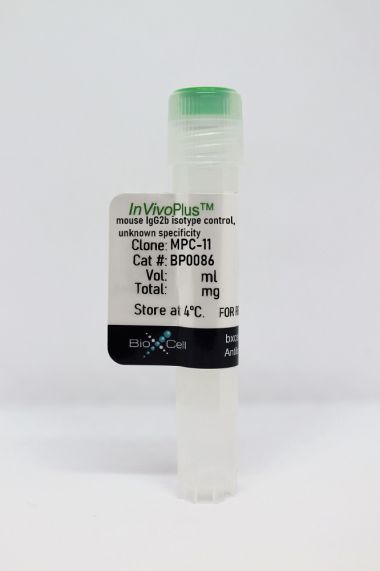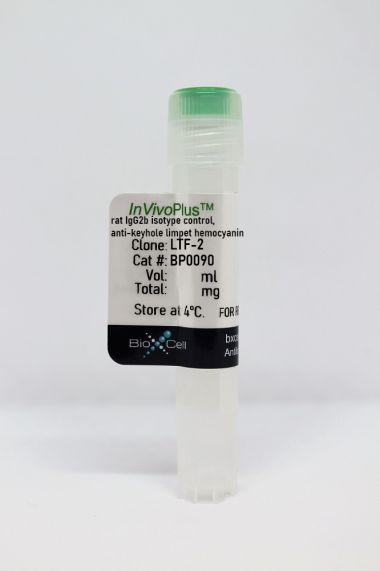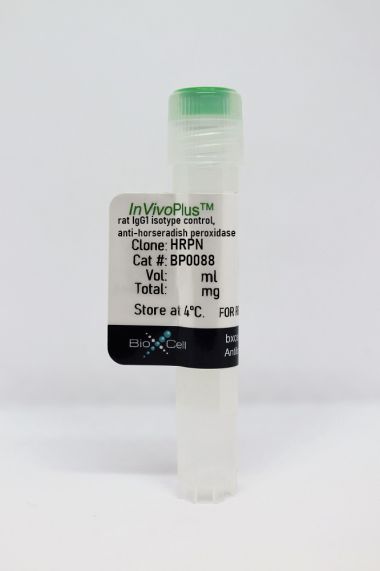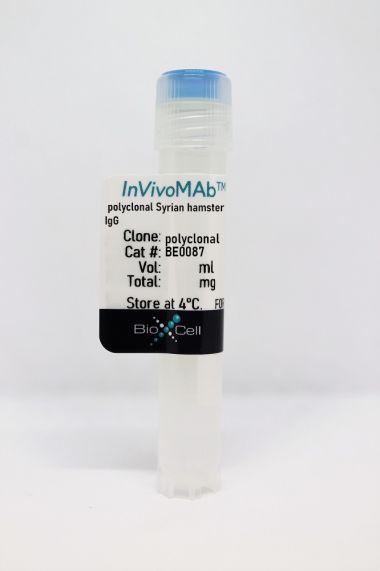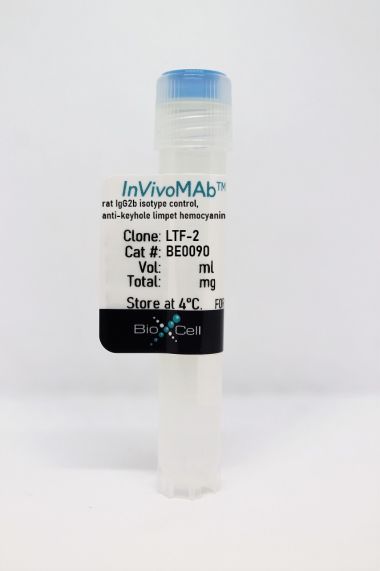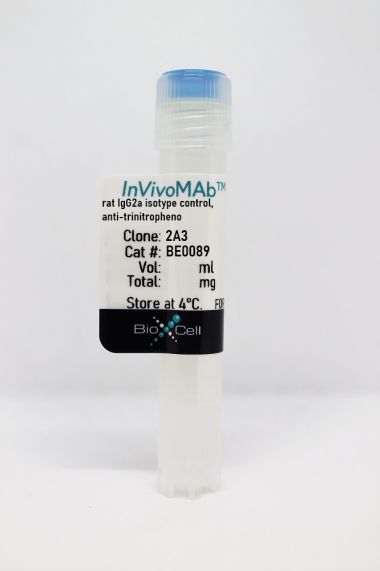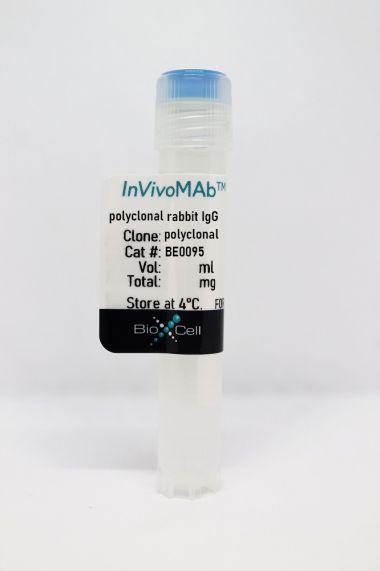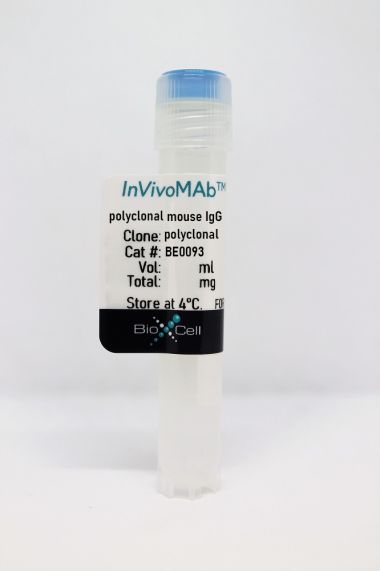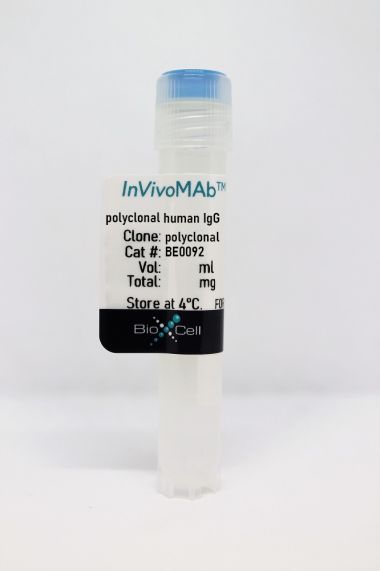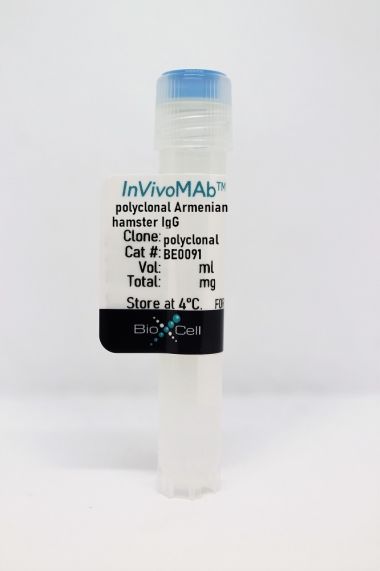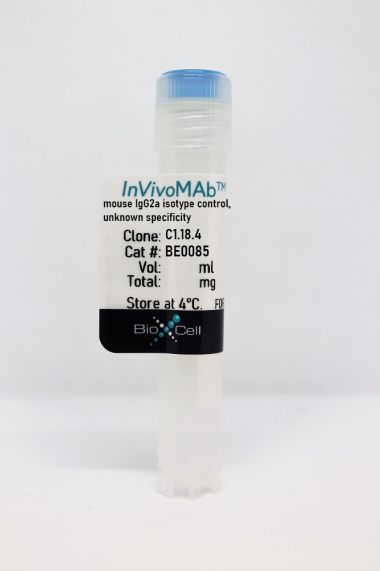InVivoMAb Armenian hamster IgG isotype control, anti-glutathione S-transferase
Product Details
The PIP monoclonal antibody reacts with glutathione-S-transferase (GST) of Schistosoma japonicum origin. Because S. japonicum GST is not expressed by mammals this antibody is ideal for use as an isotype control for Armenian hamster IgG antibodies in most in vivo and in vitro applications.Specifications
| Isotype | Armenian hamster IgG |
|---|---|
| Recommended Dilution Buffer | InVivoPure pH 7.0 Dilution Buffer |
| Conjugation | This product is unconjugated. Conjugation is available via our Antibody Conjugation Services. |
| Formulation |
PBS, pH 7.0 Contains no stabilizers or preservatives |
| Endotoxin |
<2EU/mg (<0.002EU/μg) Determined by LAL gel clotting assay |
| Purity |
>95% Determined by SDS-PAGE |
| Sterility | 0.2 µm filtration |
| Production | Purified from cell culture supernatant in an animal-free facility |
| Purification | Protein A |
| RRID | AB_2687739 |
| Molecular Weight | 150 kDa |
| Storage | The antibody solution should be stored at the stock concentration at 4°C. Do not freeze. |
Recommended Products
Young, A. R., et al. (2019). "Dermal and muscle fibroblasts and skeletal myofibers survive chikungunya virus infection and harbor persistent RNA" PLoS Pathog 15(8): e1007993. PubMed
Chikungunya virus (CHIKV) is an arthritogenic alphavirus that acutely causes fever as well as severe joint and muscle pain. Chronic musculoskeletal pain persists in a substantial fraction of patients for months to years after the initial infection, yet we still have a poor understanding of what promotes chronic disease. While replicating virus has not been detected in joint-associated tissues of patients with persistent arthritis nor in various animal models at convalescent time points, viral RNA is detected months after acute infection. To identify the cells that might contribute to pathogenesis during this chronic phase, we developed a recombinant CHIKV that expresses Cre recombinase (CHIKV-3′-Cre). CHIKV-3′-Cre replicated in myoblasts and fibroblasts, and it induced arthritis during the acute phase in mice. Importantly, it also induced chronic disease, including persistent viral RNA and chronic myositis and synovitis similar to wild-type virus. CHIKV-3′-Cre infection of tdTomato reporter mice resulted in a population of tdTomato+ cells that persisted for at least 112 days. Immunofluorescence and flow cytometric profiling revealed that these tdTomato+ cells predominantly were myofibers and dermal and muscle fibroblasts. Treatment with an antibody against Mxra8, a recently defined host receptor for CHIKV, reduced the number of tdTomato+ cells in the chronic phase and diminished the levels of chronic viral RNA, implicating these tdTomato+ cells as the reservoir of chronic viral RNA. Finally, isolation and flow cytometry-based sorting of the tdTomato+ fibroblasts from the skin and ankle and analysis for viral RNA revealed that the tdTomato+ cells harbor most of the persistent CHIKV RNA at chronic time points. Therefore, this CHIKV-3′-Cre and tdTomato reporter mouse system identifies the cells that survive CHIKV infection in vivo and are enriched for persistent CHIKV RNA. This model represents a useful tool for studying CHIKV pathogenesis in the acute and chronic stages of disease.
Zhang, R., et al. (2019). "Expression of the Mxra8 Receptor Promotes Alphavirus Infection and Pathogenesis in Mice and Drosophila" Cell Rep 28(10): 2647-2658.e2645. PubMed
Mxra8 is a recently described receptor for multiple alphaviruses, including Chikungunya (CHIKV), Mayaro (MAYV), Ross River (RRV), and O’nyong nyong (ONNV) viruses. To determine its role in pathogenesis, we generated mice with mutant Mxra8 alleles: an 8-nucleotide deletion that produces a truncated, soluble form (Mxra8(Δ8/Δ8)) and a 97-nucleotide deletion that abolishes Mxra8 expression (Mxra8(Δ97/Δ97)). Mxra8(Δ8/Δ8) and Mxra8(Δ97/Δ97) fibroblasts show reduced CHIKV infection in culture, and Mxra8(Δ8/Δ8) and Mxra8(Δ97/Δ97) mice have decreased infection of musculoskeletal tissues with CHIKV, MAYV, RRV, or ONNV. Less foot swelling is observed in CHIKV-infected Mxra8 mutant mice, which correlated with fewer infiltrating neutrophils and cytokines. A recombinant E2-D71A CHIKV with diminished binding to Mxra8 is attenuated in vivo in wild-type mice. Ectopic Mxra8 expression is sufficient to enhance CHIKV infection and lethality in transgenic flies. These studies establish a role for Mxra8 in the pathogenesis of multiple alphaviruses and suggest that targeting this protein may mitigate disease in humans.
Han, X., et al. (2019). "Role of CXCR3 signaling in response to anti-PD-1 therapy" EBioMedicine 48: 169-177. PubMed
Tumor mutations and tumor microenvironment are associated with resistance to cancer immunotherapies. However, peripheral T cell in effective anti-programmed death 1 (PD-1) antibody treatment is poorly understood. METHODS: Mass spectrometry and conventional flow cytometry were used to investigate peripheral blood cells isolated from patients. Furthermore, melanoma mouse model was performed to assess the role of CXCR3 signaling in anti-PD-1 antibody treatment. FINDINGS: We revealed a marked increase in the percentage of CXCR3(+) T cells in the blood of cancer patients after the first pembrolizumab infusion. This percentage decreased after the second infusion in responsive patients, whereas a sustained high percentage of CXCR3(+) T cells was observed in patients with progressive disease. A low percentage of CXCR3(+) T cells presented in patients with stable disease or a partial response was confirmed by conventional flow cytometry. Intriguingly, blockade of CXCR3 signaling exacerbated tumor growth in mice. Intratumoral injection with recombinant CXCL9/10 plus intraperitoneal injection of anti-PD1 antibody inhibited the tumor growth in mice. INTERPRETATION: The dynamic changes in CXCR3(+) T cells in blood may be a prognostic factor in anti-PD-1 immunotherapy, and promotion of CXCR3-mediated signaling may be beneficial to the anti-PD-1 therapy.
Bonnardel, J., et al. (2019). "Stellate Cells, Hepatocytes, and Endothelial Cells Imprint the Kupffer Cell Identity on Monocytes Colonizing the Liver Macrophage Niche" Immunity 51(4): 638-654.e639. PubMed
Macrophages are strongly adapted to their tissue of residence. Yet, little is known about the cell-cell interactions that imprint the tissue-specific identities of macrophages in their respective niches. Using conditional depletion of liver Kupffer cells, we traced the developmental stages of monocytes differentiating into Kupffer cells and mapped the cellular interactions imprinting the Kupffer cell identity. Kupffer cell loss induced tumor necrosis factor (TNF)- and interleukin-1 (IL-1) receptor-dependent activation of stellate cells and endothelial cells, resulting in the transient production of chemokines and adhesion molecules orchestrating monocyte engraftment. Engrafted circulating monocytes transmigrated into the perisinusoidal space and acquired the liver-associated transcription factors inhibitor of DNA 3 (ID3) and liver X receptor-α (LXR-α). Coordinated interactions with hepatocytes induced ID3 expression, whereas endothelial cells and stellate cells induced LXR-α via a synergistic NOTCH-BMP pathway. This study shows that the Kupffer cell niche is composed of stellate cells, hepatocytes, and endothelial cells that together imprint the liver-specific macrophage identity.
Zhang, R., et al. (2018). "Mxra8 is a receptor for multiple arthritogenic alphaviruses" Nature 557(7706): 570-574. PubMed
Arthritogenic alphaviruses comprise a group of enveloped RNA viruses that are transmitted to humans by mosquitoes and cause debilitating acute and chronic musculoskeletal disease (1) . The host factors required for alphavirus entry remain poorly characterized (2) . Here we use a genome-wide CRISPR-Cas9-based screen to identify the cell adhesion molecule Mxra8 as an entry mediator for multiple emerging arthritogenic alphaviruses, including chikungunya, Ross River, Mayaro and O’nyong nyong viruses. Gene editing of mouse Mxra8 or human MXRA8 resulted in reduced levels of viral infection of cells and, reciprocally, ectopic expression of these genes resulted in increased infection. Mxra8 bound directly to chikungunya virus particles and enhanced virus attachment and internalization into cells. Consistent with these findings, Mxra8-Fc fusion protein or anti-Mxra8 monoclonal antibodies blocked chikungunya virus infection in multiple cell types, including primary human synovial fibroblasts, osteoblasts, chondrocytes and skeletal muscle cells. Mutagenesis experiments suggest that Mxra8 binds to a surface-exposed region across the A and B domains of chikungunya virus E2 protein, which are a speculated site of attachment. Finally, administration of the Mxra8-Fc protein or anti-Mxra8 blocking antibodies to mice reduced chikungunya and O’nyong nyong virus infection as well as associated foot swelling. Pharmacological targeting of Mxra8 could form a strategy for mitigating infection and disease by multiple arthritogenic alphaviruses.
- Cancer Research,
- Immunology and Microbiology
Enhancement of Radiation Therapy through Blockade of the Immune Checkpoint, V-domain Ig Suppressor of T Cell Activation (VISTA), in Melanoma and Adenocarcinoma Murine Models.
In International Journal of Molecular Sciences on 6 September 2023 by Duval, K. E. A., Tavakkoli, A., et al.
PubMed
Radiation therapy (RT) has recently demonstrated promise at stimulating an enhanced immune response. The recent success of immunotherapies, such as checkpoint inhibitors, CART cells, and other immune modulators, affords new opportunities for combination with radiation. The aim of this study is to evaluate whether and to what extent blockade of VISTA, an immune checkpoint, can potentiate the tumor control ability of radiation therapy. Our study is novel in that it is the first comparison of two VISTA-blocking methods (antibody inhibition and genetic knockout) in combination with RT. VISTA was blocked either through genetic knockout (KO) or an inhibitory antibody and combined with RT in two syngeneic murine flank tumor models (B16 and MC38). Selected mRNA, immune cell infiltration, and tumor growth delay were used to assess the biological effects. When combined with a single 15Gy radiation dose, VISTA blockade via genetic knockout in the B16 model and via anti-VISTA antibodies in the MC38 model significantly improved survival compared to RT alone by an average of 5.5 days and 6.3 days, respectively (p < 0.05). The gene expression data suggest that the mechanism behind the enhanced tumor control is primarily a result of increased apoptosis and immune-mediated cytotoxicity. VISTA blockade significantly enhances the anti-tumor effect of a single dose of 15Gy radiation through increased expression and stimulation of cell-mediated apoptosis pathways. These results suggest that VISTA is a biologically relevant immune promoter that has the potential to enhance the efficacy of a large single radiation dose in a synergic manner.
- Cancer Research,
- Immunology and Microbiology,
- Neuroscience,
- Stem Cells and Developmental Biology
Neoantigen-specific stem cell memory-like CD4+ T cells mediate CD8+ T cell-dependent immunotherapy of MHC class II-negative solid tumors.
In Nature Immunology on 1 August 2023 by Brightman, S. E., Becker, A., et al.
PubMed
CD4+ T cells play key roles in a range of immune responses, either as direct effectors or through accessory cells, including CD8+ T lymphocytes. In cancer, neoantigen (NeoAg)-specific CD8+ T cells capable of direct tumor recognition have been extensively studied, whereas the role of NeoAg-specific CD4+ T cells is less well understood. We have characterized the murine CD4+ T cell response against a validated NeoAg (CLTCH129>Q) expressed by the MHC-II-deficient squamous cell carcinoma tumor model (SCC VII) at the level of single T cell receptor (TCR) clonotypes and in the setting of adoptive immunotherapy. We find that the natural CLTCH129>Q-specific repertoire is diverse and contains TCRs with distinct avidities as measured by tetramer-binding assays and CD4 dependence. Despite these differences, CD4+ T cells expressing high or moderate avidity TCRs undergo comparable in vivo proliferation to cross-presented antigen from growing tumors and drive similar levels of therapeutic immunity that is dependent on CD8+ T cells and CD40L signaling. Adoptive cellular therapy (ACT) with NeoAg-specific CD4+ T cells is most effective when TCR-engineered cells are differentiated ex vivo with IL-7 and IL-15 rather than IL-2 and this was associated with both increased expansion as well as the acquisition and stable maintenance of a T stem cell memory (TSCM)-like phenotype in tumor-draining lymph nodes (tdLNs). ACT with TSCM-like CD4+ T cells results in lower PD-1 expression by CD8+ T cells in the tumor microenvironment and an increased frequency of PD-1+CD8+ T cells in tdLNs. These findings illuminate the role of NeoAg-specific CD4+ T cells in mediating antitumor immunity via providing help to CD8+ T cells and highlight their therapeutic potential in ACT. © 2023. The Author(s).
- Mus musculus (House mouse),
- Cancer Research,
- Immunology and Microbiology
Antigen-presenting type-I conventional dendritic cells facilitate curative checkpoint blockade immunotherapy in pancreatic cancer
Preprint on BioRxiv : the Preprint Server for Biology on 6 March 2023 by Mahadevan, K. K., Dyevoich, A. M., et al.
PubMed
Inflammation and tissue damage associated with pancreatitis can precede or occur concurrently with pancreatic ductal adenocarcinoma (PDAC). We demonstrate that in PDAC coupled with pancreatitis (ptPDAC), antigen-presenting type-I conventional dendritic cells (cDC1s) are specifically activated. Immune checkpoint blockade therapy (iCBT) leads to cytotoxic CD8 + T cell activation and eradication of ptPDAC with restoration of lifespan even upon PDAC re-challenge. Such eradication of ptPDAC was reversed following specific depletion of dendritic cells. Employing PDAC antigen-loaded cDC1s as a vaccine, immunotherapy-resistant PDAC was rendered sensitive to iCBT with a curative outcome. Analysis of the T-cell receptor (TCR) sequences in the tumor infiltrating CD8 + T cells following cDC1 vaccination coupled with iCBT identified unique CDR3 sequences with potential therapeutic significance. Our findings identify a fundamental difference in the immune microenvironment and adaptive immune response in PDAC concurrent with, or without pancreatitis, and provides a rationale for combining cDC1 vaccination with iCBT as a potential treatment option.
- Immunology and Microbiology
FcγRIV is required for IgG2c mediated enhancement of RBC alloimmunization.
In Frontiers in Immunology on 4 October 2022 by Qiu, A., Miller, A., et al.
PubMed
Passive immunization with anti-D can prevent maternal alloimmunization to RhD thereby preventing hemolytic disease of the fetus and newborn. Unexpectedly, anti-D fails in some cases and some monoclonal anti-D preparations paradoxically enhances alloimmunization. The underlying mechanisms modulating humoral alloimmunization by anti-D are unknown. We previously reported that IgG antibody subclasses differentially regulate alloimmunity in response to red blood cell (RBC) transfusions in a mouse model; in particular, IgG2c significantly enhanced RBC alloantibody responses. Initial mechanistic studies revealed that IgG2c:RBC immune complexes were preferentially consumed by the splenic dendritic cell (DC) subsets that play a role in RBC alloimmunization. The deletion of activating Fc-gamma receptors (FcγRs) (i.e., FcγRI, FcγRIII, and FcγRIV) on DCs abrogated IgG2c-mediated enhanced alloimmunization. Because DCs express high levels of FcγRIV, which has high affinity for the IgG2c subclass, we hypothesized that FcγRIV was required for enhanced alloimmunization. To test this hypothesis, knockout mice and blocking antibodies were used to manipulate FcγR expression. The data presented herein demonstrate that FcγRIV, but not FcγRI or FcγRIII, is required for IgG2c-mediated enhancement of RBC alloantibody production. Additionally, FcγRI is alone sufficient for IgG2c-mediated RBC clearance but not for increased alloimmunization, demonstrating that RBC clearance can occur without inducing alloimmunization. Together, these data, combined with prior observations, support the hypothesis that passive immunization with an RBC-specific IgG2c antibody increases RBC alloantibody production through FcγRIV ligation on splenic conventional DCs (cDCs). This raises the question of whether standardizing antibody subclasses in immunoprophylaxis preparations is desirable and suggests which subclasses may be optimal for generating monoclonal anti-D therapeutics. Copyright © 2022 Qiu, Miller, Zotti, Santhanakrishnan, Hendrickson, Tredicine, Stowell, Luckey, Zimring and Hudson.
- Cancer Research,
- Immunology and Microbiology
CXCL10-armed oncolytic adenovirus promotes tumor-infiltrating T-cell chemotaxis to enhance anti-PD-1 therapy.
In Oncoimmunology on 13 September 2022 by Li, X., Lu, M., et al.
PubMed
Resistance remains an obstacle to anti-programmed cell death protein 1 (PD-1) therapy in human cancer. One critical resistance mechanism is the lack of T cell chemotaxis in the tumor microenvironment (TME). CXCL10-CXCR3 signaling is required for T cell tumor infiltration and tumor immunotherapy. Oncolytic viruses (OVs), including oncolytic adenoviruses (AdVs), induce effective T cell immunity and tumor infiltration. Thus, arming OV with CXCL10 would be an attractive strategy to overcome resistance to anti-PD1 therapy. Here, we successfully constructed a novel recombinant oncolytic adenovirus encoding murine CXCL10, named Adv-CXCL10. Through intratumoural injection, the continuous expression of the functional chemokine CXCL10 in the TME is realized to recruit more CXCR3+ T cells into the TME to kill tumor cells, and the recombinant adenovirus shows great power to 'fire up' the TME and enhance the antitumour efficiency of PD-1 antibodies. © 2022 The Author(s). Published with license by Taylor Francis Group, LLC.
- Immunology and Microbiology,
- Neuroscience
Secondary influenza challenge triggers resident memory B cell migration and rapid relocation to boost antibody secretion at infected sites.
In Immunity on 12 April 2022 by MacLean, A. J., Richmond, N., et al.
PubMed
Resident memory B (BRM) cells develop and persist in the lungs of influenza-infected mice and humans; however, their contribution to recall responses has not been defined. Here, we used two-photon microscopy to visualize BRM cells within the lungs of influenza -virus immune and reinfected mice. Prior to re-exposure, BRM cells were sparsely scattered throughout the tissue, displaying limited motility. Within 24 h of rechallenge, these cells increased their migratory capacity, localized to infected sites, and subsequently differentiated into plasma cells. Alveolar macrophages mediated this process, in part by inducing expression of chemokines CXCL9 and CXCL10 from infiltrating inflammatory cells. This led to the recruitment of chemokine receptor CXCR3-expressing BRM cells to infected regions and increased local antibody concentrations. Our study uncovers spatiotemporal mechanisms that regulate lung BRM cell reactivation and demonstrates their capacity to rapidly deliver antibodies in a highly localized manner to sites of viral replication.Copyright © 2022 The Author(s). Published by Elsevier Inc. All rights reserved.
Microbial signals and lymphotoxin drive TNF-independent death of A20 and ABIN-1 deficient epithelium
Preprint on BioRxiv : the Preprint Server for Biology on 8 November 2021 by Rusu, I., Mennillo, E., et al.
PubMed
h4>ABSTRACT/h4> Anti-TNF antibodies are effective for treating patients with inflammatory bowel disease (IBD), but many patients fail to respond to anti-TNF therapy, highlighting the importance of TNF-independent disease. We previously demonstrated that acute deletion of two IBD susceptibility genes, A20 ( Tnfaip3 ) and Abin-1 ( Tnip1 ), in intestinal epithelial cells (IECs) sensitizes mice to both TNF-dependent and TNF-independent death. Here we show that TNF-independent IEC death after A20 and Abin-1 deletion is rescued by germ-free derivation or deletion of MyD88 , while deletion of Trif provides only partial protection. Combined deletion of Ripk3 and Casp8 , which inhibits both apoptotic and necroptotic death, completely protects against death after acute deletion of A20 and Abin-1 in IECs. A20 and Abin-1 -deficient IECs are sensitized to TNF-independent, TNFR-1-mediated death in response to lymphotoxin alpha (LTα) homotrimers. Blockade of LTα in vivo reduces weight loss and improves survival when combined with partial deletion of MyD88 . These data show that microbial signals, MyD88 , and LTα all contribute to TNF-independent intestinal injury. h4>SUMMARY/h4> Here we show that germ-free derivation, MyD88 deletion, combined Ripk3 and Casp8 deletion, or anti-LTα, all reduce TNF-independent intestinal injury after A20 and Abin-1 deletion.
- Block,
- Mus musculus (House mouse),
- Immunology and Microbiology
Stellate Cells, Hepatocytes, and Endothelial Cells Imprint the Kupffer Cell Identity on Monocytes Colonizing the Liver Macrophage Niche.
In Immunity on 15 October 2019 by Bonnardel, J., T'Jonck, W., et al.
PubMed
Macrophages are strongly adapted to their tissue of residence. Yet, little is known about the cell-cell interactions that imprint the tissue-specific identities of macrophages in their respective niches. Using conditional depletion of liver Kupffer cells, we traced the developmental stages of monocytes differentiating into Kupffer cells and mapped the cellular interactions imprinting the Kupffer cell identity. Kupffer cell loss induced tumor necrosis factor (TNF)- and interleukin-1 (IL-1) receptor-dependent activation of stellate cells and endothelial cells, resulting in the transient production of chemokines and adhesion molecules orchestrating monocyte engraftment. Engrafted circulating monocytes transmigrated into the perisinusoidal space and acquired the liver-associated transcription factors inhibitor of DNA 3 (ID3) and liver X receptor-α (LXR-α). Coordinated interactions with hepatocytes induced ID3 expression, whereas endothelial cells and stellate cells induced LXR-α via a synergistic NOTCH-BMP pathway. This study shows that the Kupffer cell niche is composed of stellate cells, hepatocytes, and endothelial cells that together imprint the liver-specific macrophage identity.Copyright © 2019 The Authors. Published by Elsevier Inc. All rights reserved.
- Control,
- In Vivo,
- Mus musculus (House mouse)
Role of CXCR3 signaling in response to anti-PD-1 therapy.
In EBioMedicine on 1 October 2019 by Han, X., Wang, Y., et al.
PubMed
Tumor mutations and tumor microenvironment are associated with resistance to cancer immunotherapies. However, peripheral T cell in effective anti-programmed death 1 (PD-1) antibody treatment is poorly understood. Mass spectrometry and conventional flow cytometry were used to investigate peripheral blood cells isolated from patients. Furthermore, melanoma mouse model was performed to assess the role of CXCR3 signaling in anti-PD-1 antibody treatment. We revealed a marked increase in the percentage of CXCR3+ T cells in the blood of cancer patients after the first pembrolizumab infusion. This percentage decreased after the second infusion in responsive patients, whereas a sustained high percentage of CXCR3+ T cells was observed in patients with progressive disease. A low percentage of CXCR3+ T cells presented in patients with stable disease or a partial response was confirmed by conventional flow cytometry. Intriguingly, blockade of CXCR3 signaling exacerbated tumor growth in mice. Intratumoral injection with recombinant CXCL9/10 plus intraperitoneal injection of anti-PD1 antibody inhibited the tumor growth in mice. The dynamic changes in CXCR3+ T cells in blood may be a prognostic factor in anti-PD-1 immunotherapy, and promotion of CXCR3-mediated signaling may be beneficial to the anti-PD-1 therapy. FUND: This work was supported by the National Natural Science Foundation of China (Nos. 81722047, 81871944, 81670553, 81874317, 81572389, 81730100) and Jiangsu province key medical talents (Nos. ZDRCA2016026), The "Deng Feng" Distinguished Scholars Program, National Science Technology Major Project "Key New Drug Creation and Manufacturing Program", China (Number: 2018ZX09201002), and the Fundamental Research Funds for the Central Universities (020814380117). Copyright © 2019 The Authors. Published by Elsevier B.V. All rights reserved.
- In Vivo,
- Control,
- Mus musculus (House mouse),
- Immunology and Microbiology
Expression of the Mxra8 Receptor Promotes Alphavirus Infection and Pathogenesis in Mice and Drosophila.
In Cell Reports on 3 September 2019 by Zhang, R., Earnest, J. T., et al.
PubMed
Mxra8 is a recently described receptor for multiple alphaviruses, including Chikungunya (CHIKV), Mayaro (MAYV), Ross River (RRV), and O'nyong nyong (ONNV) viruses. To determine its role in pathogenesis, we generated mice with mutant Mxra8 alleles: an 8-nucleotide deletion that produces a truncated, soluble form (Mxra8Δ8/Δ8) and a 97-nucleotide deletion that abolishes Mxra8 expression (Mxra8Δ97/Δ97). Mxra8Δ8/Δ8 and Mxra8Δ97/Δ97 fibroblasts show reduced CHIKV infection in culture, and Mxra8Δ8/Δ8 and Mxra8Δ97/Δ97 mice have decreased infection of musculoskeletal tissues with CHIKV, MAYV, RRV, or ONNV. Less foot swelling is observed in CHIKV-infected Mxra8 mutant mice, which correlated with fewer infiltrating neutrophils and cytokines. A recombinant E2-D71A CHIKV with diminished binding to Mxra8 is attenuated in vivo in wild-type mice. Ectopic Mxra8 expression is sufficient to enhance CHIKV infection and lethality in transgenic flies. These studies establish a role for Mxra8 in the pathogenesis of multiple alphaviruses and suggest that targeting this protein may mitigate disease in humans. Copyright © 2019 The Author(s). Published by Elsevier Inc. All rights reserved.
- In Vivo,
- Mus musculus (House mouse),
- Genetics,
- Immunology and Microbiology
Dermal and muscle fibroblasts and skeletal myofibers survive chikungunya virus infection and harbor persistent RNA.
In PLoS Pathogens on 1 August 2019 by Young, A. R., Locke, M. C., et al.
PubMed
Chikungunya virus (CHIKV) is an arthritogenic alphavirus that acutely causes fever as well as severe joint and muscle pain. Chronic musculoskeletal pain persists in a substantial fraction of patients for months to years after the initial infection, yet we still have a poor understanding of what promotes chronic disease. While replicating virus has not been detected in joint-associated tissues of patients with persistent arthritis nor in various animal models at convalescent time points, viral RNA is detected months after acute infection. To identify the cells that might contribute to pathogenesis during this chronic phase, we developed a recombinant CHIKV that expresses Cre recombinase (CHIKV-3'-Cre). CHIKV-3'-Cre replicated in myoblasts and fibroblasts, and it induced arthritis during the acute phase in mice. Importantly, it also induced chronic disease, including persistent viral RNA and chronic myositis and synovitis similar to wild-type virus. CHIKV-3'-Cre infection of tdTomato reporter mice resulted in a population of tdTomato+ cells that persisted for at least 112 days. Immunofluorescence and flow cytometric profiling revealed that these tdTomato+ cells predominantly were myofibers and dermal and muscle fibroblasts. Treatment with an antibody against Mxra8, a recently defined host receptor for CHIKV, reduced the number of tdTomato+ cells in the chronic phase and diminished the levels of chronic viral RNA, implicating these tdTomato+ cells as the reservoir of chronic viral RNA. Finally, isolation and flow cytometry-based sorting of the tdTomato+ fibroblasts from the skin and ankle and analysis for viral RNA revealed that the tdTomato+ cells harbor most of the persistent CHIKV RNA at chronic time points. Therefore, this CHIKV-3'-Cre and tdTomato reporter mouse system identifies the cells that survive CHIKV infection in vivo and are enriched for persistent CHIKV RNA. This model represents a useful tool for studying CHIKV pathogenesis in the acute and chronic stages of disease.
- Control,
- In Vitro,
- Homo sapiens (Human)
Mxra8 is a receptor for multiple arthritogenic alphaviruses.
In Nature on 1 May 2018 by Zhang, R., Kim, A. S., et al.
PubMed
Arthritogenic alphaviruses comprise a group of enveloped RNA viruses that are transmitted to humans by mosquitoes and cause debilitating acute and chronic musculoskeletal disease 1 . The host factors required for alphavirus entry remain poorly characterized 2 . Here we use a genome-wide CRISPR-Cas9-based screen to identify the cell adhesion molecule Mxra8 as an entry mediator for multiple emerging arthritogenic alphaviruses, including chikungunya, Ross River, Mayaro and O'nyong nyong viruses. Gene editing of mouse Mxra8 or human MXRA8 resulted in reduced levels of viral infection of cells and, reciprocally, ectopic expression of these genes resulted in increased infection. Mxra8 bound directly to chikungunya virus particles and enhanced virus attachment and internalization into cells. Consistent with these findings, Mxra8-Fc fusion protein or anti-Mxra8 monoclonal antibodies blocked chikungunya virus infection in multiple cell types, including primary human synovial fibroblasts, osteoblasts, chondrocytes and skeletal muscle cells. Mutagenesis experiments suggest that Mxra8 binds to a surface-exposed region across the A and B domains of chikungunya virus E2 protein, which are a speculated site of attachment. Finally, administration of the Mxra8-Fc protein or anti-Mxra8 blocking antibodies to mice reduced chikungunya and O'nyong nyong virus infection as well as associated foot swelling. Pharmacological targeting of Mxra8 could form a strategy for mitigating infection and disease by multiple arthritogenic alphaviruses.



